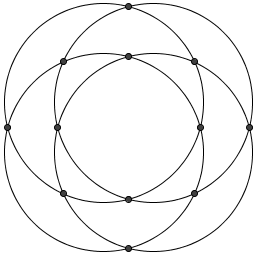2002 AMC 12B Problems/Problem 14
- The following problem is from both the 2002 AMC 12B #14 and 2002 AMC 10B #18, so both problems redirect to this page.
Contents
[hide]Problem
Four distinct circles are drawn in a plane. What is the maximum number of points where at least two of the circles intersect?
![]()
Solution 1
For any given pair of circles, they can intersect at most ![]() times. Since there are
times. Since there are  pairs of circles, the maximum number of possible intersections is
pairs of circles, the maximum number of possible intersections is ![]() . We can construct such a situation as below, so the answer is
. We can construct such a situation as below, so the answer is ![]() .
.
Solution 2
Because a pair or circles can intersect at most ![]() times, the first circle can intersect the second at
times, the first circle can intersect the second at ![]() points, the third can intersect the first two at
points, the third can intersect the first two at ![]() points, and the fourth can intersect the first three at
points, and the fourth can intersect the first three at ![]() points. This means that our answer is
points. This means that our answer is ![]()
See also
| 2002 AMC 10B (Problems • Answer Key • Resources) | ||
| Preceded by Problem 17 |
Followed by Problem 19 | |
| 1 • 2 • 3 • 4 • 5 • 6 • 7 • 8 • 9 • 10 • 11 • 12 • 13 • 14 • 15 • 16 • 17 • 18 • 19 • 20 • 21 • 22 • 23 • 24 • 25 | ||
| All AMC 10 Problems and Solutions | ||
| 2002 AMC 12B (Problems • Answer Key • Resources) | |
| Preceded by Problem 13 |
Followed by Problem 15 |
| 1 • 2 • 3 • 4 • 5 • 6 • 7 • 8 • 9 • 10 • 11 • 12 • 13 • 14 • 15 • 16 • 17 • 18 • 19 • 20 • 21 • 22 • 23 • 24 • 25 | |
| All AMC 12 Problems and Solutions | |
The problems on this page are copyrighted by the Mathematical Association of America's American Mathematics Competitions. ![]()










